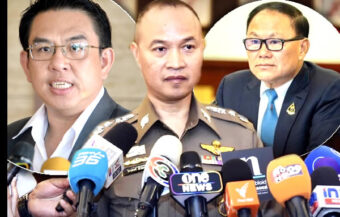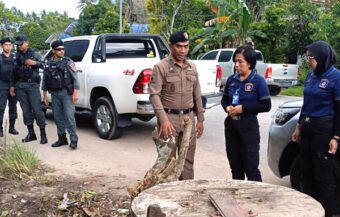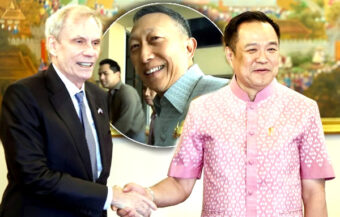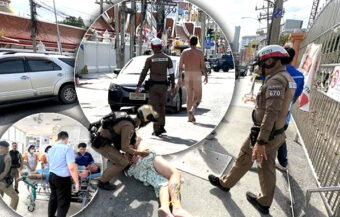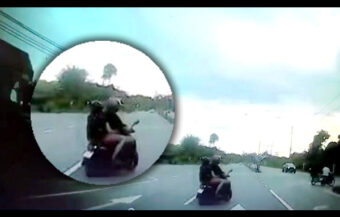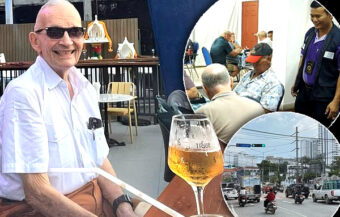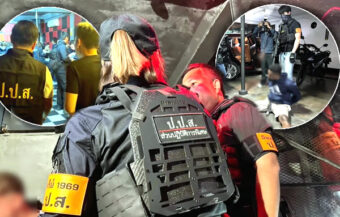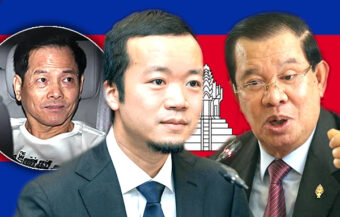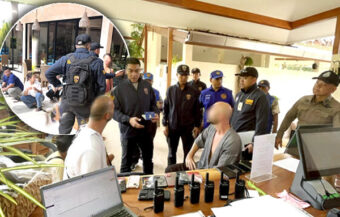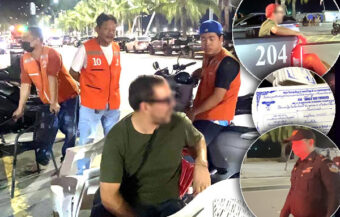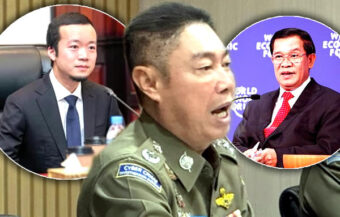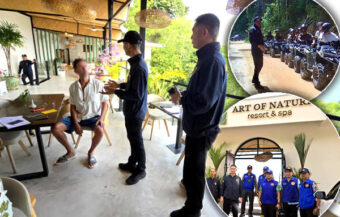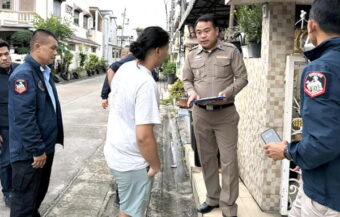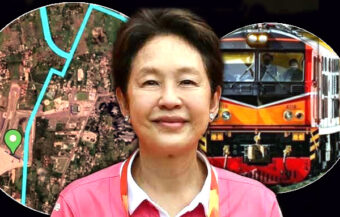Thailand reels after 14 killed—including 13 civilians—and 100,000+ evacuated as Cambodian rockets and artillery strike border areas. Thai military boosts defences with more artillery targeting Cambodian forces. Fierce cross-border fighting leads to urgent evacuations.
Thailand entered day two of its escalating border clash with Cambodia, reeling from a brutal day that left 14 dead — 13 civilians and one soldier. As rockets fell and gunfire echoed, over 100,000 people were forced to flee their homes along the eastern frontier. In response, the Thai military bolstered its defences, rolling out more artillery aimed squarely at Cambodian positions. Meanwhile, the charred remains of eight civilians still lie inside the ruins of a 7-Eleven store in Kantharalak District, Sisaket. The shop was obliterated by a BM-21 rocket barrage, reportedly launched on the direct orders of Cambodia’s strongman leader, Hun Sen.

Thailand awoke on Friday morning to a deepening crisis, albeit with a stronger sense of national unity. Overnight, authorities assessed the damage after fierce fighting erupted along the Cambodian border. Multiple areas were hit by artillery and rocket fire, with civilians caught in the crossfire.
According to the Ministry of Public Health, 14 people were confirmed dead. Among the victims, one was a Thai soldier while the remaining thirteen were civilians. Notably, eight civilians were killed instantly when a Cambodian BM-21 rocket struck a 7-Eleven store.
The store was situated inside a PTT gas station complex in Kantharalak District, Sisaket Province. Shortly after impact, the building was engulfed in flames, leaving little trace of the structure or its victims.
Emergency teams unable to recover bodies as ongoing shelling keeps forensic units from accessing site
By early Friday, emergency recovery teams had still not retrieved the bodies. Ongoing shelling in the vicinity made access to the site impossible. Officials confirmed that security conditions remained too dangerous for forensic units to safely enter.
Meanwhile, the 2nd Army Region released a comprehensive summary of Thursday’s battlefield developments. According to their timeline, hostilities began at 8:20 a.m. when Cambodian troops launched an artillery barrage east of Prasat Ta Muen. This location sits near Thailand’s Wild Boar military base. In response, Thai forces retaliated swiftly with coordinated ground manoeuvres and airstrikes.
Importantly, two Cambodian tanks were destroyed near Prasat Don Tuan during the exchanges. In addition to ground combat, multiple BM-21 rockets were fired into the Kantharalak District. These rockets landed dangerously close to fuel depots, homes, and civilian gathering points.
Elsewhere, clashes broke out near Phra Viharn, stretching from Wat Kaew to the hills of Phu Makhuea. As of Friday morning, both sides maintained their respective positions in the contested terrain. While the frontlines had not shifted, the situation remained tense and volatile.
Cambodian troops deploy heavy weapons targeting military checkpoints and civilians in Chong Chom
In the Chong Chom sector, Cambodian troops reportedly deployed heavy-calibre weapons. They targeted not only Thai military checkpoints but also civilian structures. These included a local vocational college, private residences, and the Thai-Cambodian Border Area Development Centre. According to senior officials, there were no signs that the bombardment would stop.
As a result of the Cambodian assault, Thai authorities invoked Article 51 of the United Nations Charter. This provision enables a nation to defend itself in the event of an attack. Thailand stressed that it would respond with precision, targeting only military assets. Cultural sites and civilian zones, officials said, would be strictly avoided.
Simultaneously, the Ministry of Foreign Affairs escalated the matter to the United Nations. Minister Maris Sangiampongsa presented Thailand’s position, stating that the airstrikes were necessary. According to his briefing, Cambodian artillery had killed Thai civilians, prompting defensive retaliation. He emphasised that Cambodia had initiated the aggression.
In total, eleven areas across four provinces were damaged by Cambodian fire. These provinces included Surin, Buriram, Ubon Ratchathani and Sisaket. The affected areas included schools, homes, fuel stations and government facilities.
Cambodian artillery damages villages, schools, fuel stations and government facilities in 4 provinces
For example, ten artillery shells struck Nong Raet Village in Surin, damaging over a dozen buildings. In Ban Phue, Sisaket Province, BM-21 rockets landed near a Border Patrol Police outpost and a commercial gas station. Dom Pradit, located in Ubon Ratchathani, suffered damage to municipal infrastructure. Fortunately, there were no reported injuries in that specific incident.
Buriram Province endured similar attacks. In Ban Khilek, five shells were documented by local authorities. In Ban Kok Krachai, three more exploded near residential streets. Overall, seven separate impact zones were identified in Buriram alone.
Because of these escalating attacks, Thai officials ordered mass evacuations across the border provinces. According to the Ministry of the Interior, 100,672 people were relocated on Thursday. These evacuees were spread across temporary shelters in six provinces.
Surin recorded the highest displacement, with more than 56,000 residents moved to 67 designated shelters. In Sisaket, 17,196 people were taken to 58 locations prepared for long-term safety. Ubon Ratchathani and Buriram reported 10,476 and 17,000 evacuees, respectively.
Interior ministry orders evacuations and protection plans as over 100,000 displaced from border provinces
In response, Interior Minister Phumtham Wechayachai issued a nationwide directive to local governors. He instructed them to implement rear-area protection plans. Consequently, village heads, district officers and defence volunteers were mobilised. Together, they coordinated with national agencies to ensure orderly evacuations.
Notably, evacuees were provided with essential aid, including meals, medicine, drinking water, and hygiene supplies. Mobile kitchens were activated to prepare hot food. Temporary toilets and medical tents were set up at all major shelters.
Meanwhile, hospitals near the border zones also took emergency action. Kantharalak Hospital in Sisaket Province conducted a rapid evacuation of 170 patients. This decision followed reports of increased artillery fire near the facility.
Ambulances from 22 districts were deployed to assist. Patients were transferred to Sriratana and Sisaket provincial hospitals. According to witnesses, the evacuation created chaos and panic. Several people wept openly as medical staff worked urgently to clear the wards.
Additional rocket strikes destroy homes and expand evacuations as thousands return from Cambodia
At 2:50 p.m., another BM-21 rocket slammed into a house in Village 5, Kantharalak District. The structure was destroyed completely. Fortunately, the occupants had already evacuated earlier that day.
As a precaution, Thai officials expanded evacuations to seven sub-districts and 80 villages. These included Phu Pha Mok, Sao Thong Chai, Rung, Lalai, Non Samran, Bueng Malu, and Cham. Officials stated that the evacuations were preemptive, based on threat assessments.
Later that evening, over 3,000 Thai nationals crossed back into the country from Cambodia. Most were workers employed in markets, casinos, and hotels in the Poipet area. They returned through the Khlong Luek checkpoint in Sa Kaeo Province.
In anticipation of the influx, border officials extended checkpoint hours until 6:00 p.m. Some returnees had been waiting since dawn. Due to the intense heat, several people fainted in line. Medical personnel were on-site to provide assistance.
Sa Kaeo Province remains calm as thousands return from Cambodia amid extended checkpoint hours
Despite the regional conflict, Sa Kaeo Province remained relatively calm. Officials clarified that it was not considered an active conflict zone.
Later that night, the Ministry of Public Health held a press briefing. Spokesman Dr. Varoth Chotpitayasunondh updated casualty figures. Fourteen people were confirmed dead. An additional 46 individuals were injured. Among them, seven civilians and six soldiers were listed in critical condition.
In total, 13 civilians and one soldier had died in the fighting. The injured included people with light wounds and those in serious condition. All were being treated in public hospitals across the affected regions.
Despite mounting tension, Acting Prime Minister Phumtham Wechayachai had not issued a formal national address, limiting himself to his role as Interior Minister. However, according to cabinet sources, he remained closely engaged. Military commanders continued to monitor the situation hour by hour. A National Security Council meeting took place at Government House at 2 p.m. on Thursday.
Acting Prime Minister stays focused on interior ministry role while military commanders take the lead
Indeed, a notable aspect of this conflict so far has been that the government in Bangkok has deferred to military commanders in the field. Royal Thai Army Commander-in-Chief General Phana Khlaeoplotthuk took personal command on Thursday, joining Region 2 Commander Lieutenant General Boonsin Padklang in the conflict zone.
The Second Army Region issued warnings to Cambodian forces. Specifically, they demanded that Cambodian troops cease targeting civilians or historic religious sites. Thai officials stressed that retaliation would be measured but resolute.
According to statements from military and foreign affairs leaders, Thailand would act within international law. The use of force would remain proportionate. Civilian safety remained the highest priority.
At present, the conflict remains localised to the border areas. Nevertheless, concerns persist that the fighting could widen. Diplomatic avenues remain open but fragile.
Military leaders take charge on the ground, urging restraint and warning Cambodia over targeting civilians
Officials have urged the public to stay calm. They have advised people to monitor only official channels for updates. The spread of false or exaggerated information, they warned, could increase panic and confusion.
Although military options are still under review, Thailand is focusing its efforts on protecting civilians and restoring peace. The Ministry of Public Health, alongside other agencies, continues to provide medical and psychological support at shelters. Emergency services remain fully active.
Thai border sealed and citizens in Cambodia urged to get home as war rages in deadly cross border fire
Evacuations continue as Cambodian shells and missiles rain down on Thai civilians as hostilities rage
Hostilities flare up at multiple points after Cambodia attacked Thailand after 7 am with rockets and artillery
Acting PM and military top brass respond decisively to second landmine incident as Thai soldier loses leg
While the situation is fluid and dangerous, Thailand stands united. The government is coordinating across sectors to protect its people, defend its territory and seek international support for a resolution.
Join the Thai News forum, follow Thai Examiner on Facebook here
Receive all our stories as they come out on Telegram here
Follow Thai Examiner here
Further reading:
Military blasts Cambodia for breaching international law by planting mines which injured 3 soldiers
Dangerous impasse between Thailand and Cambodia as PM rules out International Court of Justice (ICJ)
Hun Manet confirms Cambodia ultimately may decide to send border dispute with Thailand to the Hague
Khmer soldier killed in deadly gunfire between Thai and Cambodian armies near Ubon Ratchathani
Thaksin to address state board on drug suppression despite howls of protest from human rights groups
Health Minister Somsak launches regulatory blitz to outlaw non-medical cannabis use within 40 days

